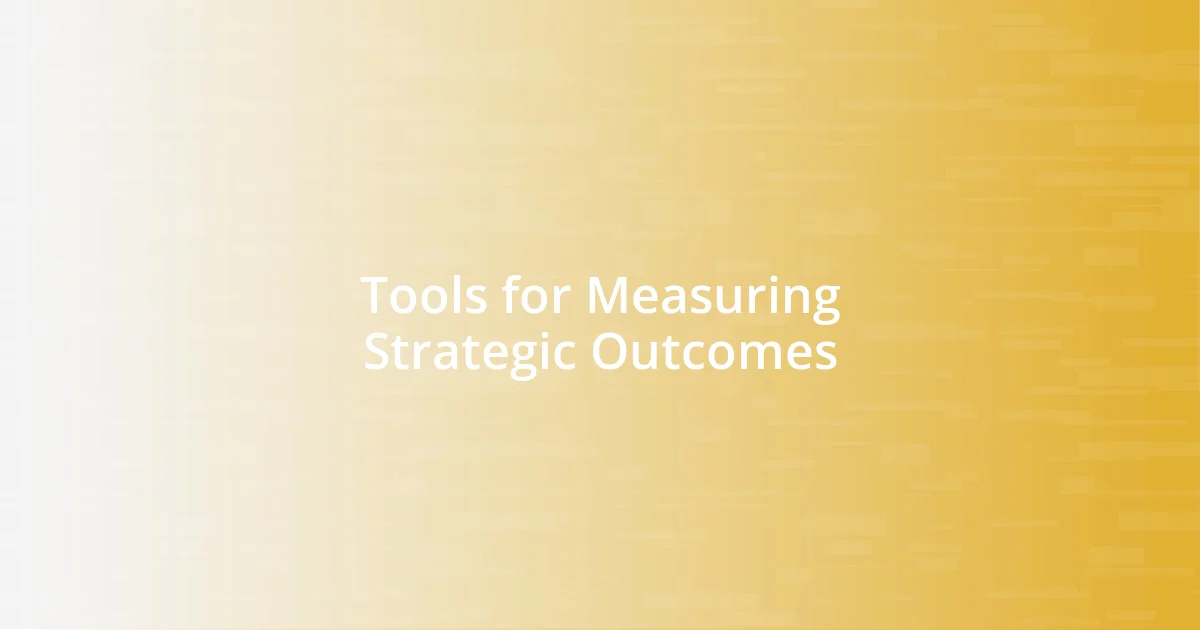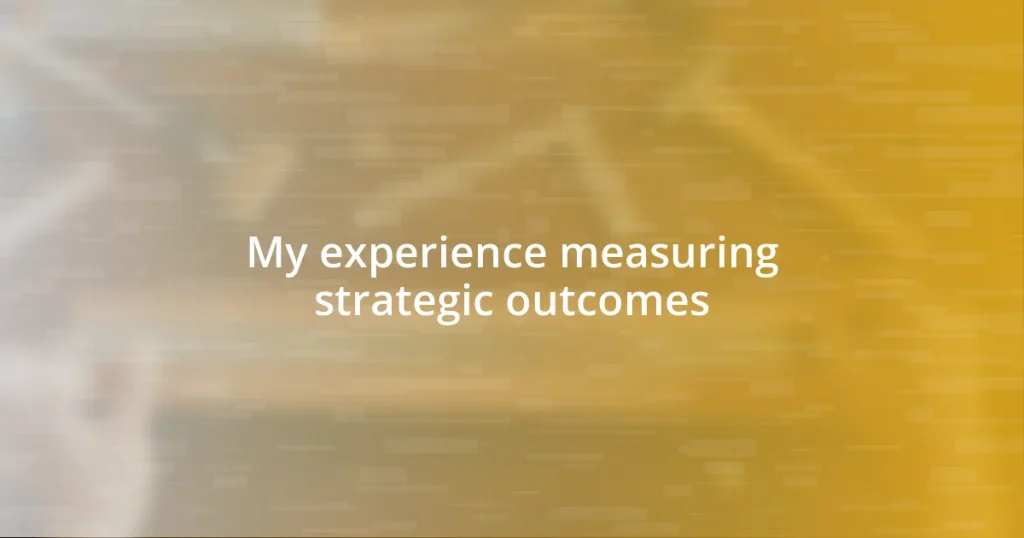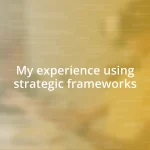Key takeaways:
- Measuring strategic outcomes provides clarity, fosters accountability, and supports informed decision-making, helping teams align efforts with goals.
- Utilizing a mix of data collection methods, including surveys, interviews, and observations, enhances understanding and insights into project outcomes.
- Implementing changes based on findings requires collaborative dialogue and ongoing communication to adapt strategies and foster team ownership.

Understanding Strategic Outcomes
Strategic outcomes are the tangible benefits that arise from a well-executed plan, reflecting how closely we align our activities with our overarching objectives. I remember the first time I was involved in measuring these outcomes; it was both daunting and exciting. It made me question: how can we truly gauge success without understanding the impact of our actions?
When I started tracking strategic outcomes, I realized that they’re not just numbers on a report; they represent real progress in fulfilling our mission. For instance, in a project I managed, we aimed to enhance customer engagement. Seeing a direct correlation between our outreach efforts and increased customer satisfaction gave me a profound sense of purpose. Don’t you find it exhilarating when your hard work translates into measurable results?
Understanding strategic outcomes is critical because they help us pivot and refine our efforts. I often reflect on past initiatives and ask myself what we might have done differently to amplify those outcomes. This introspection not only feeds my growth but also solidifies the importance of continuous improvement in our strategic endeavors.

Importance of Measuring Outcomes
Measuring outcomes is vital because it provides clarity on whether our strategies are hitting the mark. I recall a particular project where we focused on streamlining operations. By quantifying the time saved and costs reduced, it suddenly became clear how much more efficient we had become. It felt like shining a spotlight on our progress, and that moment was incredibly rewarding.
Additionally, outcomes measurement fosters accountability. In my experience, sharing metrics with my team created a shared sense of responsibility. When we celebrated small wins, like an increase in online engagement, it motivated everyone to keep pushing. It’s more than just tracking numbers; it’s about creating a team culture built on transparency and shared success.
Lastly, measuring outcomes allows for informed decision-making. During a campaign where we lacked clear metrics initially, I felt lost. Once we integrated outcome measurements, we could see what resonated with our audience. This shift not only felt empowering but also restored my confidence in guiding our next steps. Knowing where we stand is crucial for determining where we go next.
| Aspect | Importance |
|---|---|
| Clarity | Reveals if strategies are effective |
| Accountability | Fosters shared responsibility and motivation |
| Informed Decision-making | Guides future strategies based on data |

Tools for Measuring Strategic Outcomes
When it comes to measuring strategic outcomes, I’ve found that using the right tools can significantly enhance the accuracy and effectiveness of the data we collect. For example, I once relied on a project management software that not only tracked milestones but also integrated real-time data analytics. This allowed me to visualize our progress in a way that was both impressive and motivating. It felt like having a personal dashboard reflecting our achievements, and I often shared these insights with my team to keep spirits high.
Here are some key tools that I believe play a vital role in measuring strategic outcomes:
- Performance Management Software: Helps monitor key performance indicators (KPIs) and track progress toward strategic goals.
- Surveys and Feedback Tools: Gather direct input from stakeholders, providing qualitative data that complements quantitative measures.
- Data Analytics Platforms: Allow for the analysis of large datasets, helping to identify trends and correlations related to strategic initiatives.
- Balanced Scorecard: A framework that helps organizations translate strategic objectives into actionable metrics across multiple perspectives.
- Project Management Tools: Offer insights into project timelines, costs, and resource allocation, making it easier to assess effectiveness.
Drawing from my own experience, the integration of these tools transformed how I viewed outcomes. I became more confident in my decisions knowing I had robust data backing our strategies. The blend of qualitative and quantitative insights was like having a well-rounded picture of our activities — it sparked a sense of clarity and direction that was refreshing.

Methods for Data Collection
When it comes to data collection, I’ve discovered that a variety of methods can work wonders in painting a clear picture of outcomes. One approach I’ve frequently employed is combining surveys with direct interviews. I remember a time when feedback from surveys alone seemed superficial. However, by having candid conversations with team members, I uncovered richer insights. It not only deepened my understanding but also fostered trust within the team. How often do we overlook the value of real conversations in favor of just data points?
Additionally, utilizing observational techniques can be incredibly powerful. During a recent project evaluation, I made it a point to sit in on team meetings. Watching interactions firsthand revealed dynamics that spreadsheets simply couldn’t convey. It was eye-opening to see how collaboration efforts translated into outcomes. Have you ever experienced the difference between reading about body language in a report and witnessing it live? The former just doesn’t compare.
Lastly, experiments or pilot programs can serve as an invaluable method for data collection. I once implemented a small-scale test for a new marketing strategy before rolling it out company-wide. Collecting data on its performance allowed me to tweak elements in real-time. It felt like steering a ship; making small adjustments on the fly created a sense of control and direction. How often do you get a chance to test the waters before diving in completely? These methods, tailored to the context, can yield substantial insights for more effective decision-making.

Analyzing Collected Data
When analyzing the collected data, I often find myself diving deep into the numbers, looking not just for trends but for stories behind those trends. One time, I uncovered a surprising dip in our project engagement metrics. It was tempting to brush it off as a blip, but my intuition nudged me to dig deeper. Upon analysis, I discovered that a change in our communication strategy had turned team members off. This revelation illuminated how critical it is to look beyond the surface data; sometimes the most telling insights are hidden just beneath.
I also believe that visualizing data can transform how we interpret results. In one of my earlier projects, I used graphs and heat maps to plot our strategic outcomes. The visuals were not just pretty pictures; they acted like guides, pointing out areas needing attention and celebration. Have you ever noticed how a well-placed chart can shift your focus dramatically? It shifts the data from mere numbers into a narrative that sparks discussions within the team, reinforcing our strategic objectives.
Moreover, collaboration during analysis can be a game-changer. I once invited my team to a workshop where we collectively reviewed our performance data. The diverse perspectives brought energy to the discussion, leading us to question assumptions and draw different conclusions. How often do we underestimate the power of collaboration in interpreting data? Each team member had a unique lens, enriching our understanding and fostering a sense of ownership over our strategic journey. This hands-on involvement turned analysis from a solitary task into a shared exploration, deepening our commitment to the outcomes we were striving for.

Evaluating Impact of Results
Evaluating the impact of results often feels like putting together a puzzle, where each piece reveals a greater picture. I remember a project where we implemented a new client feedback system, and the results were threefold. Not only did our satisfaction scores rise, but the comments and suggestions provided were rich with detail, leading to actionable changes that genuinely improved our service. Reflecting on that experience, I realized how critical it is to assess both quantitative and qualitative outcomes to truly capture the essence of what changes we’ve implemented.
Another aspect I value in evaluating impact is the emotional engagement of stakeholders. During a review of our latest initiative, I gauged the reactions of both the team and clients during presentations. There was a palpable excitement in the room, which echoed in our follow-up engagement metrics. Have you ever felt how a shared vision can elevate the perception of success? This emotional response can often be an indicator of future commitment and advocacy for the project, helping to solidify its importance in our strategic framework.
Ultimately, I’ve learned that the evaluation process is ongoing. In one instance, after we celebrated the initial successes of a marketing campaign, I insisted we set up follow-up sessions for continuous feedback. The insights from these discussions not only provided a pulse on the project but also kept the team motivated and aligned with our overarching goals. Thus, evaluating impact isn’t just a checkbox on a checklist—it’s a dialogue that nurtures the connection between strategy and execution.

Implementing Changes Based on Findings
Implementing changes based on findings can feel like steering a ship in new waters. I remember a pivotal moment when our team identified that a lack of clarity in our objectives led to misalignment. Rather than just tweaking the existing plans, we held a deep-dive session where each member could voice their insights. It was inspiring to see the collective will to adapt and innovate, reinforcing the idea that change is not just necessary—it’s a shared responsibility.
One notable instance comes to mind when we developed an agile feedback loop after receiving input from our review sessions. Seeing the enthusiasm on my team’s faces when we discussed incorporating real-time customer feedback into our product roadmaps was truly electrifying. This collaborative approach made us realize something vital: when team members see their insights valued, it cultivates ownership that can turn resistance into enthusiastic participation. Isn’t it fascinating how collaboration can open doors to creativity we never knew existed?
I’ve also learned that implementing changes requires ongoing communication. After launching new initiatives based on our findings, I organized regular check-ins to discuss the adjustments and gather further insights. I vividly recall a meeting where a colleague voiced concerns about the changes, leading us to reassess our approach. This dialogue not only alleviated tension but also strengthened our strategy moving forward. How often do we miss these critical moments of reflection? Engaging continuously with team members ensures that everyone feels included in the journey, which in turn enhances commitment to our collective goals.















